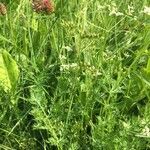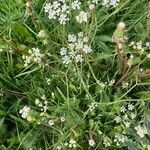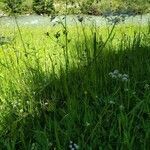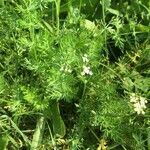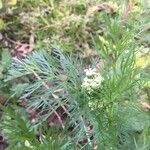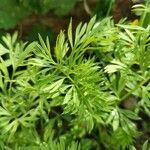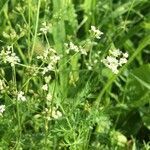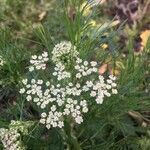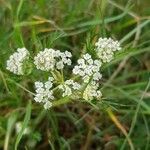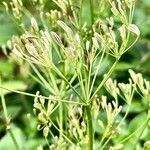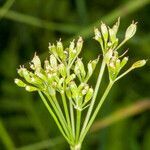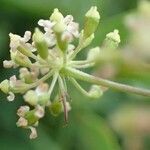Stems to 55 cm, erect, terete, striate. Petioles to 13 cm, upper ones gradually shorter, uppermost ones absent, all of them with a sheath with membranous margin and auriculate apex; lamina to 13 by 5 cm, oblong, bipinnate, segments divided. Compound umbels terminal to the stems and its branches; peduncles 1-11 cm; rays 5-8, ½-2cm; pedicels 6-14, 1½-5 mm, to 9 mm in fruit; involucres none or 1, subulate; involucels none. Calyx teeth none. Petals to 1¼ by 1 mm, obcordate with short inflexed tips, white. Mericarps 4-5 by 1 mm, often falcate, ribs distinct, yellowish. Stylopodium bipartite, halves low-conical.
A herb. The plant takes two years to grow then flower. It is an erect herb. It grows about 40 cm high. The root is thick, long and tapering like a carrot. It has a pale colour. The leaves are twice divided. The upper leaves are smaller and less divided. The leaves are pale green. The flowers are white. The fruit are oblong and narrow. They usually have distinct ribs. These dark brown fruit are 5-6 mm long. Caraway is more curved and darker in colour than cumin.
Glabrous biennial to 1 m; lfls ovate, pinnately dissected into linear segments 5–15 mm; peduncles 5–13 cm; rays 7–14, ascending, 2–4 cm; pedicels ascending, 1–12 mm; involucel wanting or nearly so; fr 3–4.5 mm, half as wide, prominently ribbed; 2n=20. Native of Eurasia, sometimes cult. and often established as a weed in waste places; Nf. to B.C., s. to Va., Ind., and Mo., commoner northward. June–Aug.
